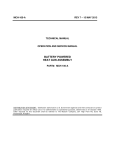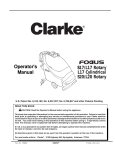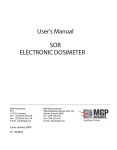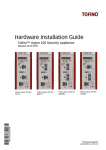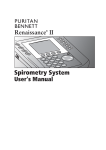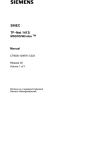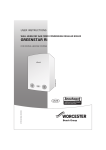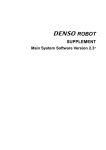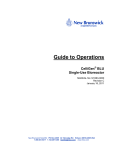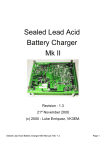Download Universal Portable Charger Dual-Position BTC
Transcript
OPERATION AND SERVICE MANUAL SPC LITE Universal Portable Charger Dual-Position BTC-70819 NSN 6130-01-555-7817 USA Tel: (631) 499-5155 · Fax: (631) 499-5504 email address: [email protected] www.bren-tronics.com 850036-1 REV E WARNING HIGH VOLTAGES ARE PRESENT IN THE OPERATION OF THIS EQUIPMENT Avoid contact with AC supply voltage connections during installation, operation or maintenance of the battery charger. CAUTION ACID CONTAMINATES NICKEL-CADMIUM, LITHIUM-ION, LITHIUM-POLYMER and NICKEL-METAL HYDRIDE BATTERIES Every effort must be made to keep Nickel-Cadmium, Lithium-Ion, Lithium Polymer and Nickel-Metal Hydride batteries as far away as possible from Lead-Acid batteries because Lead-Acid batteries contain sulfuric acid. Do Not use the same tools and materials, such as screwdrivers, wrenches, syringes, hydrometers, and gloves for both types of batteries. Any trace of acid or acid fumes will permanently damage Nickel-Cadmium, Lithium-Ion, Lithium Polymer and NickelMetal Hydride batteries on contact. WARNING NO SMOKING IS PERMITTED NEAR THE CHARGING STATION Batteries can produce explosive gases during charging or discharge cycles. Never smoke or allow open flames near the charging station. Table of Contents CHAPTER 1 – INTRODUCTION Para Scope......................................................... 1-1 Technical Specifications…………………... 1-2 Declaration of Conformity .......................... 1-3 Accessories…………………………………. 1-4 Charge Cycle Description…………………. 1-5 Updating Charger Software……………… 1-6 CHAPTER 2 – OPERATING PROCEDURES Panel Controls and Indicators……………. 2-1 Preliminary Setup Procedures…………… 2-2 Charging Batteries………………………… 2-3 Battery Revitalization and De-Storage….. 2-4 Blackout…………………………………….. 2-5 Battery Charger Labels……………. 2-6 Solid Red Fault LED Troubleshooting…… 2-7 Flashing Red Fault LED Troubleshooting.. 2-8 850036-1 REV E Para Pg Pg 1-1 1-2 1-3 1-4 1-7 1-8 Operation in Extreme Environmental Conditions............................................ Preparation for Movement..................... Battery State-of-Charge Displays.......... Battery Capacity Retention.................... Battery Storage..................................... 2-1 2-4 2-5 2-6 2-7 2-8 2-9 2-9 CHAPTER 3 – MAINTENANCE INSTRUCTIONS Introduction............................................. 3-1 3-1 Cleaning................................................. 3-2 3-1 Inspection............................................... 3-3 3-1 Basic Functional Test............................. 3-4 3-2 Simplified Operator Troubleshooting Procedures................ 3-5 3-3 Warranty / Repair Information................ 3-6 3-5 Upgrade / Update Information................ 3-7 3-5 2-9 2-10 2-11 2-12 2-13 2-10 2-11 2-11 2-12 2-12 INTRODUCTION CHAPTER 1 INTRODUCTION 1-1. SCOPE The Soldier Portable Charger Lite (P/N BTC-70819) is a state-of-the-art, high performance lightweight portable battery charger designed for field deployment or shop usage. It provides fast reactivation of various rechargeable batteries. It is capable of simultaneously charging two batteries completely unattended. The Soldier Portable Charger Lite (SPC Lite) is simple to use by design. Without any user intervention, the SPC Lite typically charges two batteries. The charge time for a fully discharged BB-2590/U or BB-390B/U is less than 3.5 hours. The Charge times are substantially less for partially discharged batteries. The charger automatically identifies the specific battery type and provides the appropriate charge profile. Based on the current operating environment, the SPC Lite automatically customizes the charge profile to provide the quickest charge in a safe manner. The charge status for the two batteries is conveyed to the user via three easy-to-understand panel mounted LED indicators (amber – CHARGE, green – READY and red – FAULT). The SPC Lite is universal by design. It can readily use either AC or DC input power – whichever is most convenient for the user. The universal AC input fully allows 90-264 VAC and 47-440 Hz operation without any adjustment or user intervention. Additionally, the DC input power permits a range of 22-33 VDC, standard on most military vehicles. The Charger is available with an additional 12 VDC input. This allows the Charger to be powered from an 11-18 VDC such as a standard 12 VDC automotive system. When operated with either DC power source, an Under-voltage Lockout Circuit prevents the Charger from excessively discharging the vehicle battery so there is always enough power to restart the vehicle. The SPC Lite is adaptive by design. It is microprocessor controlled and is presently programmed to automatically charge over 50 different battery types (and growing) as listed in Table 1. With the appropriate battery adapter, however, it can be readily reprogrammed via the RS232 software upgrade port in the field to charge a countless number of additional battery types and chemistries including: Nickel Metal Hydride, Nickel Cadmium, Lithium Ion, and Lithium Polymer. The battery charger components are housed in a durable, solid polypropylene case. The assembled unit is watertight when the cover is securely latched and the pressure equalization valve is closed. 850036-1 REV E 1-1 INTRODUCTION 1-2. TECHNICAL SPECIFICATIONS Dimensions……………………….. 13.73 inches (348.8 mm) W x 10.28 inches (261 mm) D x 7.65 inches (194.4 mm) H Weight (less adapters and cables)…...13 lbs. (5.9 kg) Power Requirements AC Operation……………... Automatic Selection: 90 to 260 VAC, single-phase, 47 to 440 Hz 28V DC Operation………...22 to 33 VDC, 13A 12V DC Operation………...11 to 18 VDC, 20A (BTC-70819-3 Only) Charging Output Voltage………... Automatically selected for each battery type Duty Cycle………………………… Continuous Protective Features………………. Resettable circuit breakers: AC ( 3A) 28 VDC (13A) 12 VDC (20A) Operating Temp. Range………… -4°F (-20°C) to +122°F (+50°C) Storage Temp. Range…………… -40°F (-40°C) to +158°F (+70°C) Case Material ……………………. Solid Polypropylene Case Color………………………... Olive Drab #34088 per Fed-Std-595B Shipment………………………….. No restrictions 850036-1 REV E 1-2 INTRODUCTION 1-3. DECLARATION OF CONFORMITY 850036-1 REV E 1-3 INTRODUCTION 1-4. ACCESSORIES Table 1 shows the various batteries and appropriate adapter plates the SPC Lite supports at the time this document was written. Table 2 shows various power cables and accessories. Table 1 – Supported Batteries and Adapters ADAPTER BTA-70360 BTA-70394 BTA-70395 (1) ADAPTER NSN 6130-01-555-7818 5940-01-427-9247 5940-01-427-9183 BTA-70396 5940-01-427-9278 BTA-70443 5940-01-467-8813 BTA-70492A 5940-01-513-5662 BTA-70557 BTA-70574 BTA-70581 BTA-70581A BTA-70582 5940-01-467-5852 5940-01-483-6772 --5940-01-544-3476 --- BTA-70582-1 --- BTA-70589 BTA-70589A BTA-70598 BTA-70715 850036-1 REV E 6130-01-564-8116 --- --5940-01-573-9693 BATTERY BB-4600 BB-503A/U BB-326/U BB-516A/U BB-2847A/U BB-2847/U BB-2600/U BB-2600A/U BT-70477 BT-70492 BT-70492A BB-557/U ICOM SI CSEL CSEL ALI 124 ALI 142/BA-682A BA-682B BA-684A ALI 124 ALI 142/BA-682A BA-682B BA-684A ALI 116 ALI 124 ALI 142/BA-682A ALI 143/BA-687A ALI 243 BA-684A BA-685A BA-682B ALI 147 ALI 247 ALI 142/BA-682A ALI 143/BA-687A ALI 243 BA-684A BA-685A BA-682B ALI 147 ALI 247 BT-70598 BT-70593 BT-70715 1-4 TYPE NiCd NiCd NiMH NiCd Li Ion Li Ion Li Ion Li Ion NiMH Li Ion Li Ion NiCd NiCd Li Ion Li Ion NiCd Li Ion Li Ion Li Ion NiCd Li Ion Li Ion Li Ion NiCd NiCd Li Ion Li Ion Li Ion Li Ion Li Ion Li Ion Li Ion Li Ion Li Ion Li Ion Li Ion Li Ion Li Ion Li Ion Li Ion Li Ion Li Ion Li Ion Li Ion BATTERY NSN 6140-13-113-0171 6140-01-419-8193 6140-01-533-7674 6140-01-419-8191 6140-01-493-8092 6140-01-419-8194 6140-01-467-5853 6140-01-490-4311 6140-14-513-5369 6140-01-523-9840 6140-01-523-9840 6140-01-071-5070 --6140-01-534-3856 6140-01-534-3856 --6140-14-328-2258 6140-14-561-1542 6140-14-529-5971 --6140-14-328-2258 6140-14-561-1542 6140-14-529-5971 ----6140-14-328-2258 6140-14-530-0061 6140-14-553-4062 6140-14-529-5971 6140-14-529-5973 6140-14-561-1542 ----6140-14-328-2258 6140-14-530-0061 6140-14-553-4062 6140-14-529-5971 6140-14-529-5973 6140-14-561-1542 ----------- INTRODUCTION BTA-70721 BTA-70732 BTA-70737 BTA-70740 BTA-70763 BTA-70774 6130-01-573-4962 ------6130-01-555-7821 5940-01-573-9679 BTA-70807 BTA-70808 5940-01-493-6750 5940-01-493-6388 BTA-70810 BTA-70811 BTA-70812 5940-01-493-6751 5940-01-493-7622 5940-01-492-7238 BTA-70817 BTA-70834 --5940-01-501-3312 BTA-70899 --- BTA-70858 BTA-70406-3 BTA-70851 (1) BTA-70852 BTA-70853 BTA-70872 BTA-70868 --------------- BTA-70706-1 BTA-70406 BTA-70661 BTA-70685 BTA-70838-7 ----------- BT-70721 BT-70732 BT-70737 BT-70740 BN-2250 Motorola – NNTN7032A NTN9816A NTN9815A BB-2800/U BB-2588/U BB-388/U THALES – MBITR AA CELLS BB-2557/U BB-557/U D CELLS BB-2590/U BT-70791A BT-70791E BB-390B/U BB-590/U BT-70876 SAFT – SAI-2590 BB-2590/U BB-390B/U BT-70791A BT-70791E BT-70899A BT-70876 Saft – SAI-2590 Ultralife – UBI-2590 DRT 4453/4411 BA-386 Racal 931 PTR-349 Loral – RT1606 BB-NM10 LI-145 LI-80 BB-2598 BB-586 BT-70661 ALKABAT BT-70838 IdZ BT-70838-2/3 IdZ Li Ion Li Ion Li Ion Li Ion NiCd Li Ion NiCd NiCd Li Ion Li Ion NiMH Li Ion NiMH Li Ion NiCd NiMH Li Ion Li Ion Li Ion NiMH NiCd Li Ion Li Ion Li Ion NiMH Li Ion Li Ion Li Ion Li Ion Li Ion Li Ion Li Ion NiCd NiCd NiCd NiCd NiCd Li Ion Li Ion Li Ion NiCd Li Ion NiCd Li Ion Li Ion --------6140-13-116-5482 --------6140-01-490-5372 6140-01-493-7623 6140-01-490-4313 ----6140-01-490-5387 6140-01-071-5070 --6140-01-490-4316 ----6140-01-490-4317 6140-01-063-3918 ----6140-01-490-4316 6140-01-490-4317 ------------------------------6140-01-084-1460 --------- NOTES: 1) The BB-516A,BB-326, and RACAL 931 can only charge with AC power on the BTC-70819. There is no limitation on the BTC-70819-3 2) The Adapter BTA-70480/3 is not compatible with this charger. 3) This list was complete at the date of publication. Additional adapters may be available, but may require updated software. 850036-1 REV E 1-5 INTRODUCTION Table 2 – Power Cables and Accessories DESCRIPTION AC Power Cord US AC Power Cord EU AC Power Cord UK DC Power Cable w/rings DC Power Cable w/allig. clips Gabriel DC Power Cable DC Hummer Cable DC Splitter Cable BB-390/2590 Self Discharger BTI P/N 591609 590233-3 590233-4 BTA-70844-24 BTA-70844-24-AL BTA-70819-24 BTA-70835 BTA-70816 BTF-70791 GENERAL P/N ------------------------------J-6362A/U CX-13560/G SDD2 NSN ------------------------------5940-01-501-6714 5995-01-505-7883 6130-01-490-4310 Figure 1-4.1: BTA-70844-24 Figure 1-4.2: BTA-70835 Figure 1-4.3: BTA-70816(for use with BTA-70835) Figure 1-4.4: BTF-70791 850036-1 REV E 1-6 INTRODUCTION 1-5. CHARGE CYCLE DESCRIPTION Each of type the battery that are capable of being charged by the Charger is connected to the charger via their respective battery adapter (plate or cable). Each adapter can charge two batteries simultaneously. The appropriate battery adapter is installed on the control panel and serves as the electrical interface between the batteries being charged and the charger circuits. The battery charger control circuits constantly monitor the following battery conditions during the charge cycle, as appropriate, to ensure that the battery is properly being charged: a. Temperature (T) b. Voltage (V) c. Current (I) d. Time (t) e. Voltage change (ΔV) f. Temperature rate of change (ΔT/Δt) The charger operation during a typical charge sequence is automatic and the battery charge status is displayed to the user by the panel LED indicators as follows: a. Detection - The charger tries to detect a battery in an adapter. The CHARGE LED (amber) blinks slowly during this process. b. Pre-charge – The charger brings the battery voltage up to a safe level before the rapid charge process begins. This step may take several minutes for a very discharged battery. The CHARGE LED (amber) blinks rapidly during this process. c. Fast Charge – A timed fast charge cycle brings the battery to approximately 90% of full charge capacity. The CHARGE LED (amber) is lit solid during this process. d. Ready – The fast charge cycle is complete. The Battery may be removed and used at this time. The READY LED (green) is lit steadily at this time. e. Trickle / Top-off – When fast charge is complete, the charger will top off of the battery to 100%. For Lithium Ion and Lithium Polymer batteries the top-off cycle will stop after the battery is 100% charged. For all other types, the Trickle / Top-off cycle is repeated indefinitely to keep the battery at 100% charge. Leaving the battery on the charger will not harm the battery. The battery may be removed and used at this time. The READY LED (green) blinks during this process. NOTE The Battery may be removed and used at anytime during the charge cycle without damage to the charger or battery. If present, the state-of-charge indicator (SOC) will display the battery condition. NOTE After removing a battery from the charger, wait for the corresponding battery status LED’s to turn off before installing a new battery. 850036-1 REV E 1-7 INTRODUCTION 1-6. UPDATING CHARGER SOFTWARE The software in the charger is field upgradeable. By loading new software into the charger, it is possible to alter its operation and add or change the charging profiles for the batteries. Loading new software into the charger is accomplished via the use of a standard RS232 interface of a personal computer (PC) running Windows 95™ or higher. Utilizing special software running on the PC in conjunction with the boot program resident within the charger, a two-way communication link is established and the revised operational parameters and battery charge profiles can be loaded into the charger. Specific instructions for upgrading the Charger software are provided with the software upgrades. 850036-1 REV E 1-8 OPERATION SECTION 2 OPERATING PROCEDURES 2-1. PANEL CONTROLS AND INDICATORS Battery charger panel components are described below and shown in Figure 2-1.1 and 2-1.2 FIGURE 2-1.1 FIGURE 2-1.2 850036-1 REV E 2-1 OPERATION Item Function 1. On/Off Switch...................................... Turns battery charger on or off. 2. AC Circuit Breaker.............................. Turns power to the charger off in an overload condition. Remove the overload condition and push to reset. 3. Power On Indicator LED (Green)……. The Power On Indicator LED lights when the charger has sufficient power from either AC or DC. 4. Low Vehicle Power LED (Red)............ The Low Vehicle power indicator lights when external DC power is too low to charge batteries. The charger will stop charging batteries until sufficient power is available from the DC course. 5. Temp Fault LED (Amber).................... The Temperature Fault indicator lights when charger temperature is too high (50°C) or too low (-20°C). The charger will stop charging batteries. 6. Blackout Switch……………………….. Enables / Disables Blackout Mode. Pressing it once turns off all panel LEDs. Pressing it again turns on all panel LEDs. Holding down the button during turn-on keeps the LED’s off during the Lamp Test. 7. DC Circuit Breakers............................ Turns power to the charger off in an overload condition. Remove the overload condition and push to reset. 8. Charge LED (Amber).......................... The Amber LED lights steady while the associated battery is being fast-charged. A slow blinking indication means the charger is trying to find a battery at the select position. A fast blinking indication means the charger is preconditioning the battery before charging it. 9. Ready LED (Green)............................ The Green LED indicates the associated battery is fully charged and ready to be removed for use. Steady light means the battery has completed fast charge. A blinking indication means the battery is being topped off. 850036-1 REV E 2-2 OPERATION 10. Fault LED (Red)................................ If the Red LED lights steadily, the associated battery, or adapter plate is defective or will not accept charge. A blinking indication means the battery’s temperature sensor or communication connection is not making contact with the adapter. 11. AC Input Connector........................... Input connection for AC cable assembly. 12. DC Input Connector.......................... Input connection for DC cable assembly. 13. Adapter Port………………………….. Provides interface connection for battery adapters. 14. Recondition Switch………………….. Activates NiCd revitalization or Li-Ion destorage. 15. Recondition LED (Amber)…………... Lights amber during revitalization / de-storage process. 16. RS-232 Port Cover………………...... Remove this cover to upgrade the charger’s software. Otherwise leave the cover in place. 17. Pressure Equalization Valve………...This valve must be loosen before the cover is opened and latches unfastened. 850036-1 REV E 2-3 OPERATION 2-2. PRELIMINARY SETUP PROCEDURES Step 1. Place the unit on the work surface. Loosen the Pressure Equalization Valve (Fig 2.1-2 #17) by unscrewing the knob two full turns in a counterclockwise direction. Unfasten latches and open cover. Step 2. Set the On/Off Switch (Fig 2.1-1 #1) to OFF position. Step 3. The cover may be removed by removing both hinge pins with pliers. Step 4. For AC operation: Connect the AC power cord from AC Input Connector (Fig 2.1-1 #11) to an AC power source and set the On/Off Switch (Fig 2.1-1 #1) to ON position. Observe that the Power On Indicator LED (Fig 2.1-1 #3) lights, the fan operates, and all the indicator LEDs blink in order (amber, then green, then red) briefly when power is first applied. Step 5. For DC operation: Connect the DC cable from the DC Input Connector (Fig 2.1-1 #12) to a DC power source such as the NATO slave receptacle found in most military vehicles. Set the On/Off Switch (Fig 2.1-1 #1) to the ON position. Observe that the Power On Indicator LED (Fig 2.1-1 #3) lights, the fan operates, and all the status indicator LEDs (Fig 2.1-1 #8, #9, and #10) blink in order (amber, green, then red) briefly when power is first applied. Note: If both Multiple Power Sources are connected: • For the BTC-70819-3 if AC and DC are connected the charger will use AC power. If 12 and 28 VDC power are connected the charger will use 28VDC. • For the BTC-70819 if AC and DC are connected the charger will use DC power. Step 6. Observe that only the Power On Indicator LED (Fig 2.1-1 #3) is lit. Step 7. Install the appropriate battery adapter into the Adapter Port (Fig 2.1-1 #13) for battery type to be charged. Install the adapter by first placing the back of the adapter into the rear retainer. Note the alignment of the pins. The connector can only be plug in one way, do not force it. Be sure that battery adapter is fully seated on the panel. For Cable adapters, line up the pins to the Adapter Port (Fig 2.1-1 #13). 18 Pin Connectors will plug in toward the right side on the charger, do not force the connector. Step 8. Observe, after a short delay, that the two amber Charge LEDs (Fig 2.1-1 #8) will blink for several seconds. This shows battery charger circuits are initialized to the selected battery adapter and are ready to accept a battery (or batteries) for charging. If all of the status indicator LEDs (Fig 2.1-1 #8, #9, and #10) for a channel light at the same time, the adapter could not be recognized or the adapter is damaged, insure it is seated correctly. If running on DC, verify that the battery is supported by DC charging (ex: the BB516 is not). Verify that the charger software revision supports the adapter and battery. 850036-1 REV E 2-4 OPERATION 2-3. CHARGING BATTERIES Step 1. With the appropriate battery adapter installed, insert the first battery to be charged into the channel “A“ battery location. Insure the battery is fully seated in the adapter. Observe that the amber Charge LED (Fig 2.1-1 #8) for the corresponding location is lit or blinking rapidly. The Charge LED (Fig 2.1-1 #8) for the “B” battery location will continue to blink if the channel “B” battery location is left empty. If the red Fault LED (Fig 2.1-1 #10) is lit, the battery or adapter may be defective, check by removing the battery and the adapter. Then reinstall the adapter and battery. If the Fault LED (Fig 2.1-1 #10) still lights, go to the Troubleshooting section (section 2.7, 2.8, and 3-5) of this Guide. Step 2. Install the next battery into the Channel B battery location. Step 3. After fast charging is complete, the amber Charge LED (Fig 2.1-1 #8) will turn off and the green Ready LED (Fig 2.1-1 #9) will be lit. The charger will then topoff the batteries that have successfully completed fast charge. The battery is slow-charged to full capacity, as indicated by the blinking green Ready LED (Fig 2.1-1 #9). For Lithium-ion batteries, the cycle will stop after the battery is 100% charged. For other types the cycle is repeated indefinitely to keep the battery at 100% charge. As long as the green Ready LED (Fig 2.1-1 #9) is lit (blinking or solid) the battery may be removed and returned to service and another battery may be installed for charging. NOTE The BB-390A/U and the BB-390B/U batteries include two independent 12-volt sections. A relay "clicking" may be heard from the battery adapter when battery sections are switched. Other types of adapters may also contain relays and click intermittently during normal operation. NOTE Battery charger power may be left ON while batteries and/or adapters are removed or replaced. Batteries may be left on the charger for long periods of time without damaging the batteries or the charger. This is true whether if the charger is on or off. 850036-1 REV E 2-5 OPERATION 2-4. BATTERY REVITALIZATION AND DE-STORAGE The procedures outlined below describe the means of invoking the Revitalization and De-storage functions of the charger as well as the sequence of operations the charger will execute to perform the commanded tasks. NiCd and Ni-Mh Batteries are revitalized. Li-Ion batteries are de-stored. The charger will decide what to do based on the batteries’ chemistry. a. NiCad and Ni-Mh Revitalization Due to the increased power dissipation from discharging the batteries, this function will not operate above 45º C. The following procedure is used to invoke the Revitalization process: 1. Power up the charger. 2. Plug in adapter. 3. Once the adapter is recognized (the two amber Charge LED (Fig 2.1-1 #8) blink) press the Recondition Switch (Fig 2.1-1 #14) for the A or B channel; the amber Recondition LED (Fig 2.1-1 #15) will light for the corresponding channel. 4. Plug the battery into the activated channel. 5. Revitalization will commence upon recognition of the battery. Autonomously, the charger will perform the following revitalization sequence: 1. Check environment temperature, if the temperature is above 45º C it will not proceed. 2. Discharge the battery without a capacity measurement. 3. Fully charge the battery. 4. Discharge the battery and calculate the capacity. 5. Fully charge the battery. 6. If the capacity in step 4 is greater than or equal to 80% of the battery specification, the green Ready LED (Fig 2.1-1 #9) will light, and the Recondition LED (Fig 2.1-1 #15) will remain lit and the process is complete. 7. If the capacity in step 4 is less than 80%, steps 4 and 5 will repeat a second time. If after the second cycle the capacity is less than 80% of the battery specification, the red Fault LED (Fig 2.1-1 #10) will light. The Recondition LED (Fig 2.1-1 #15) remains lit and the process is complete. b. Li-Ion De-storage Due to the increased power dissipation from discharging the batteries, this function will not operate above 45º C. The following procedure is used to invoke the destorage process: 1. Power up the charger. 2. Plug in adapter. 3. Once the adapter is recognized (the two amber Charge LED (Fig 2.1-1 #8) blink) press the Recondition Switch (Fig 2.1-1 #14) for the A or B channel; 850036-1 REV E 2-6 OPERATION the amber Recondition LED (Fig 2.1-1 #15) will light for the corresponding channel. 4. Plug the battery into the activated channel. 5. De-storage will commence upon recognition of the battery. Autonomously, the Charger will perform the following de-storage sequence: a. Check environmental temperature, if the temperature is above 45º C it will not proceed. b. Fully discharge the battery. c. Fully charge the battery while measuring its capacity. d. Discharge the battery to 45% of it measured capacity. e. The green Ready LED (Fig 2.1-1 #9) will light, the Recondition LED (Fig 2.1-1 #15) remains lit and the process is complete. 2-5. BLACKOUT Pressing the Blackout Switch (Fig 2.1-1 #6) will turn off all the LEDs. Pressing the switch again will turn the LEDs back on. The charger will remember the correct state for all batteries. The blackout mode is disabled each time the charger is turned on. Holding the Blackout Switch (Fig 2.1-1 #6) down while turning the charger power switch on will suppress the startup LED Test. 850036-1 REV E 2-7 OPERATION 2-6. BATTERY CHARGER LABELS Shown below are the instructions contained on the "SHORT FORM - OPERATING PROCEDURE" label, attached inside the charger cover. LED INDICATIONS FOR EACH BATTERY S = STEADY, F = FLASHING S=Steady F= Flashing AMBER GREEN RED LIGHT INDICATIONS FOR EACH BATTERY RECON DEFINITION REMARKS F F LIGHTS SCROLL MOMENTARILY ADAPTERS MUST BE INSTALLED AWAITING BATTERY TO CHARGE (SLOW BLINKING) F F CHARGER START UP NO ADAPTER PRESENT F NO BATTERY PRESENT F CHARGE PREQUALIFICATION PRE-CHARGE CHECK (RAPID BLINKING) S FAST CHARGE IN PROCESS TWO BATTERIES CAN CHARGE SIMULTANEOUSLY F TRICKLE CHARGE IN PROCESS BATTERY IS READY TO USE; REMOVE WHEN READY S CHARGE IS COMPLETE S FAULTY BATTERY: DO NOT USE F CONTACT PINS ARE DIRTY OR DAMAGED CLEAN BATTERY CONTACTS; CHECK ADAPTER PINS RECONDITION/DESTORE CYCLE IN PROCESS RECONDITION (Ni); DESTORE (Li) RECONDITION/DESTORE FAILED CONSULT STANDARD OPERATING PROCEDURE EXCESSIVE TEMPERATURE FOR RECONDITIONING RELOCATE TO COOLER ENVIRONMENT INCOMPATIBLE BATTERY OR ADAPTER. INSUFFICIENT DC VOLTAGE TO CHARGE THIS BATTERY TYPE UNSUPPORTED OR SOFTWARE UPDATE REQUIRED S S S BATTERY IS READY TO USE; REMOVE WHEN READY CONSULT STANDARD OPERATING PROCEDURE S F S S S S S S 850036-1 REV E 2-8 USE AN AC POWERSOURCE OPERATION 2-7. SOLID RED FAULT LED TROUBLESHOOTING 1. Remove the battery and inspect all the contacts, clean if necessary. Note the battery location. 2. Reinstall at the same location for another charge cycle. 3. If the Fault LED (Fig 2.1-1 #10) is lit again at the same location remove battery and do the following: a. If the battery is NiCad or Ni-Mh and was in storage, try to revitalize the battery (see section 2.4). b. Check battery: If the battery is older than 3 yrs, it may be ready for disposal. c. Check the warranty instructions on the battery. If the warranty is expired or no instructions were given on the battery, dispose of the battery. d. Note success/failure of the future battery charges at this battery location. If the Fault LED (Fig 2.1-1 #10) is lit again, the adapter may need to be changed. 2-8. FLASHING RED FAULT LED TROUBLESHOOTING 1. This condition is telling you that some of the battery contacts are not connecting to the charger. a. For BB-390 and other batteries with thermistors, the thermal contacts may not be making proper contact with the adapter. b. For Falcon, CSEL, MBITR, and other batteries the communication pin(s) may not be making proper contact with the adapter. c. To minimize this issue; before you first start using the charger, ensure the battery contacts are clean and the adapter contact pins are in place and retain their spring action: Check by pushing down the pins and releasing. 2. You can still charge batteries with thermal / communication pins missing or damaged, it will take longer, and may not fully charge in one cycle. 3. If the flashing "red" condition continues, note the adapter battery location and battery affected. a. Remove the battery and clean the thermal contacts. b. Check adapters again. If problem continues at this location, the adapter may need to be changed. 850036-1 REV E 2-9 OPERATION 2-9. OPERATION IN EXTREME ENVIRONMENTAL CONDITIONS Observe these precautions when the charger is operated in areas where severe climatic conditions may exist: a. Operation in Arctic Climates. The battery charger is designed to function in temperature extremes as low as -4°F (-20°C). However, when operating in arctic climates, the following precautions should be observed: (1) Handle the equipment carefully. The plastic components may become more brittle. (2) Keep the equipment clean and dry. (3) Prevent ice from forming on the charger and the batteries. Ice formations may prevent proper electrical connections. Melting ice may allow water to enter the charger. When not in use, be sure the cover is fully latched and the Pressure Equalization Valve (Fig 2.1-2 #17) is fully closed (tighten by turning the knob in clockwise direction). b. Operation in Desert Climates. The charger is designed to operate in temperature extremes as high as 122°F (50°C) and the dryness associated with a desert environment. However, the sand and dust accumulation on and in the charger may cause poor electrical connections and reduce the cooling effectiveness of the charger. Follow proper cleaning and maintenance guidelines (Section 3-2) to assure proper operation. When not in use, be sure the cover is fully latched and the Pressure Equalization Valve (Fig 2.1-2 #17) is fully closed (tighten by turning the knob in clockwise direction). c. Operation in Salt Spray. Keep the equipment clean and dry at all times and immediately wipe salt spray from all the exposed surfaces on the charger and cables and connectors. When not in use, be sure the cover is fully latched and the Pressure Equalization Valve (Fig 2.1-2 #17) is fully closed (tighten by turning the knob in clockwise direction). d. Operation in Rain. Keep the equipment dry at all times. Water penetration in the charger, cables and the connectors will cause equipment failure. When not in use, be sure the cover is fully latched and the Pressure Equalization Valve (Fig 2.1-2 #17) is fully closed (tighten by turning the knob in clockwise direction). 850036-1 REV E 2-10 OPERATION NOTE Battery charge acceptance varies with ambient temperature conditions. At temperatures lower than 32°F (0°C) or higher than 104°F (40°C) it may be necessary to initiate two complete charging cycles to achieve full charge on the battery. 2-10. PREPARATION FOR MOVEMENT a. Set the On/Off Switch (Fig 2.1-1 #1) to OFF position. b. Remove any installed batteries. c. Disconnect the AC power cable. d. Disconnect the DC power cable. e. Unplug cable type adapters. (Plate type adapter may be left installed.) f. Replace the charger cover if it was removed. g. Close the charger cover and secure latches. h. Close the Pressure Equalization Valve (Fig 2.1-2 #17) by turning clockwise until tight. 2-11. BATTERY STATE-OF-CHARGE DISPLAYS Batteries equipped with state-of-charge (SOC) displays indicate battery charge status on a five-segment LCD bar graph readout. The number of LCD segments activated corresponds to the battery’s state-of-charge as follows: Segments 0 1 2 3 4 5 State-of-Charge 0% (fully discharged) 1 to 20% 21 to 40% 41 to 60% 61 to 80% 81 to 100% (fully charged) NOTE The BB-390A/U, BB-390B/U, BB-2590/U, BB-2557/U and other batteries have two SOC indicators. Each SOC indicator provides state-of-charge indication for each of the two 12V sections. Both SOCs must display 100% for the battery to be fully charged. 850036-1 REV E 2-11 OPERATION 2-12. BATTERY CAPACITY RETENTION As shown in the adjoining graph, fully charged batteries that are stored, lose a portion of their charge due to battery chemistry. This is normal and should not be interpreted as battery failure. Storage at higher temperatures increases capacity losses, while storage at lower temperature decreases capacity losses. The graph shows that Nickel based batteries like the BB-390 lose over 30% charge/month (1% /day) on the shelf waiting to be used. The BB-2590 (a Li-Ion based battery) loses less than 10% a month on the shelf. 2-13. BATTERY STORAGE Nickel based batteries may require 1 or more charge / discharge cycles after a long period of storage. They may not charge fully on the first charge cycle. Repeat the charge if necessary using the Revitalizations feature (see section 2.4). If the battery does not fully charge after 3 cycles it may no longer be serviceable. Lithium based batteries must be charged yearly if held in storage. Long term storage of fully discharged Lithium based batteries can permanently damage the battery. They do not require charge / discharge cycling after storage. If the battery does not charge (No SOC Bars), place it back on the charger for one additional charge cycle. Do not discharge it first. If the battery does not fully charge it may no longer be serviceable. 850036-1 REV E 2-12 MAINTENANCE SECTION 3 OPERATOR MAINTENANCE INSTRUCTIONS 3-1. INTRODUCTION Periodic maintenance, inspection and cleaning will help insure the Charger is kept at full readiness. 3-2. CLEANING 1. Brush loose dirt and dust from the charger. Low-pressure air may be used to remove heavy dust from the case, connectors and power switches. Avoid blowing dust into the unit. Low-pressure air may be blown into the left and right air vents at the edge of the control panel to help remove internal dust. 2. Wipe surfaces with a damp (not wet) rag. Non-solvent cleaners may be used (Windex™, Fantastik™, and Formula 409™). Do not spray or drip water or cleaners onto the panel or into the connectors. 3. The flush mounted adapter connectors may be cleaned with electronic grade spray cleaner. Allow the cleaner to dry before installing the adapters and/or applying power to the charger. 4. The connections on the adapters may be cleaned with electronic grade spray cleaner or isopropyl alcohol. Insure the adapters are dry before using them. 3-3. INSPECTION 1. Inspect case for cracks and other damage. 2. Insure the lid gasket is in place. 3. Insure the Hinge Pins are fully inserted (some models of charger also include cover stays). 4. Insure the lid closes and can be properly latched. 5. Insure all Screws are in place and are not loose. 6. Inspect the panel and connectors for damage. 7. Inspect all adapters for excessive wear and damage. a. Inspect charger connector for bent or corroded pins. b. Inspect battery connector pins for damage or corrosion. c. Insure all spring pins are not bent and move freely. d. Note that spring pins can be removed and replaced. 8. Inspect power cords for damage. 9. Insure power switches move freely. 10. Insure the Pressure Equalization Valve (Fig 2.1-2 #17) can be tightened. 850036-1 REV E 3-1 MAINTENANCE 3-4. BASIC FUNTIONAL TEST 1. Set the On/Off Switch (Fig 2.1-1 #1) to OFF position, and remove any adapter installed. 2. Connect the charger to AC power. 3. Set the On/Off Switch (Fig 2.1-1 #1) to ON position. 4. The front panel LED’s should light in sequence. Amber, then Green, then Red. Insure all LED’s light. 5. Insure the Power On Indicator LED (Fig 2.1-1 #3) is lit and that all other indicator LEDs are off. 6. Place an adapter into the Adapter Port (Fig 2.1-1 #13). 7. Verify that the two Charge LEDs (Fig 2.1-1 #8) start to blink. 8. Press each of the Recondition Switch (Fig 2.1-1 #14) several times. Verify the Recondition LED (Fig 2.1-1 #15) alternates on then off with each press. 9. Place a battery on Channel A. Insure that the Charge LEDs (Fig 2.1-1 #8) blinks rapidly then turns on solid. 10. Repeat Step 9 for Channel B. 11. Set the On/Off Switch (Fig 2.1-1 #1) to OFF position and disconnect AC Power. 12. Connect the charger to 28 Volts DC power. 13. Set the On/Off Switch (Fig 2.1-1 #1) to ON position. 14. The front panel LED’s light in sequence. Amber, then Green, then Red. Insure all LED’s light. 15. Press the Blackout Switch (Fig 2.1-1 #6). Verify that all panel LEDs turn off. 16. Press the Blackout Switch (Fig 2.1-1 #6) again. Verify all panel LEDs resume normal operation. 17. For the BTC-70819-3 Only a. Set the On/Off Switch (Fig 2.1-1 #1) to OFF position and disconnect the 28 Volts DC Power. b. Connect the charger to 12 Volts DC power. c. Set the On/Off Switch (Fig 2.1-1 #1) to ON position. d. The front panel LED’s light in sequence. Amber, then Green, then Red. Insure all LED’s light. 18. End of test. 850036-1 REV E 3-2 MAINTENANCE 3-5. SIMPLIFIED OPERATOR TROUBLESHOOTING PROCEDURES Item MALFUNCTION 1 POSSIBLE CORRECTIVE ACTION POWER ON LED is not lit during AC operation. 2 POWER ON LED is not lit during DC operation. 3 All LED’s light and stay lit after the charger is turned on. 4 The LED’s do not blink in sequence at start up. 5 TEMP FAULT LED is lit. 6 7 8 1) Inspect Power Cord and DC Switch. 2) Reset DC Circuit Breaker. Note: The Circuit breaker is tripped if the white band is visible. 1) The unit has lost its program. a. Re-program the unit. b. The unit requires repair. Call or e-mail Bren-Tronics. Info on warranty tag. 1) Verify the Temp Fault and Veh Power indicators are not lit. 2) The unit requires repair. Call or e-mail BrenTronics. Info on warranty tag. 1) The Charger is too hot or too cold. Move the charger to a more suitable environment. 2) The air vents at the left and right side of the charger are blocked. 3) Operating the chargers edge to edge can cause overheating of the charger on the right. 4) One of the internal fans has failed. The unit requires repair. Call or e-mail Bren-Tronics. Info on warranty tag. LOW VEH PWR LED is lit. 1) If the unit is running from DC power verify the voltage is correct. 2) If the unit is running from AC power the unit requires repair. 1) Poor connection between Adapter and Charger. Inspect, clean and reseat Adapter. 2) Defective Adapter, use a different Adapter. 3) The charger does not support the Adapter. Update the charger software See para 3-7. All 3 LED’s (CHARGE, READY, FAULT) are lit. FAULT LED is lit. 850036-1 REV E 1) Inspect Power Cord and AC Switch. 2) Reset AC Circuit Breaker. Note: The Circuit breaker is tripped if the white band is visible. 1) Check battery: older than 3 yrs? Maybe ready for disposal. Discharge & recharge or Revitalize, IF RED AGAIN? 2) Check warranty instructions on battery. If not covered or no instructions, dispose of. 3) Note success/failure of future battery charges at this Port. More "RED" lights? Change adapter. 3-3 MAINTENANCE 9 FAULT LED is blinking. 1) This condition is telling you the thermal contacts on the BB-390 or communication contacts on other batteries are not making contact with the charger. To minimize this issue before you first start using the charger: Ensure…. a) Two Thermal contacts are in place in each battery position on the BB-390, or all contacts on other batteries. b) Adapter contact pins are in place and retain their spring action: Check by pushing down the pins and releasing. The pins should spring up. If not or are missing, you may be able to replace pins/adapter. c) You can still charge Batteries with contact pins missing or damaged, it will just take longer. The FAULT LED will continue to blink. 2) If flashing "red" condition after this check, Mark location of condition and battery affected. 3) You can pull batteries and clean thermal contacts on the battery. 4) Check adapters again. Mark for future review. If a problem continues at this location, change the Adapter. 1) Possible poor connection, inspect and clean battery and adapter contacts. 2) Defective adapter, use a different adapter. 3) Defective battery, replace the battery. 1) Poor connection, inspect and clean battery and adapter contact. 2) Defective adapter, use a different adapter. 3) Defective battery, replace the battery. 10 Charger never tries to charge a battery. 11 Port LED goes to Amber (CHARGE), but never turns Red (FAULT) or Green (READY), instead it turns off. 12 Recondition LED will not turn on when Recondition Switch is pressed or turns off when the battery is “Found”. Recondition LED is blinking and the Port’s Status LEDs are all off. 1) The Battery or Adapter does not support Reconditioning or Destorage. Fault LED stays lit after battery is removed. 1) Battery is defective. Cycle power to clear fault. 13 14 850036-1 REV E 3-4 1) The charger is too hot (over 45˚C) to discharge the battery. Move the charger to a cooler area. 2) The air vents at the left and right side of the charger are blocked. 3) Operating the chargers edge to edge can cause overheating of the charger on the right. 4) One of the internal fans has failed. The unit requires repair. Call or e-mail Bren-Tronics. Info on warranty tag. MAINTENANCE 3-6. WARRANTY / REPAIR INFORMATION If the Charger or Adapters fail to function they must be returned to Bren-Tronics for repair. The warranty label gives the expiration date on each unit. Contact Bren-Tronics for a Return Material Authorization (RMA) number before returning any hardware to Bren-Tronics. The part numbers, serial numbers and failure descriptions must be included for Bren-Tronics to issue an RMA number. Chargers that have been damaged by abuse or that are no longer under warranty may be returned for a repair quotation. There are no user repairable parts in the charger. Opening the charger will void the warranty. For return authorization call (631) 499-5155 or email [email protected] 3-7. UPGRADE / UPDATE INFORMATION The Charger Operation Software is field upgradeable. Updates usually add support for additional battery adapters. They may also include enhanced battery charging methods. The upgrade can be done with a PC running Windows 95 or newer in about 15 minutes. All that is required is a computer serial cable and a screwdriver. Information about new adapters and software can be found at: http://www.bren-tronics.com Call (631) 499-5155 or Email [email protected] 850036-1 REV E 3-5



























